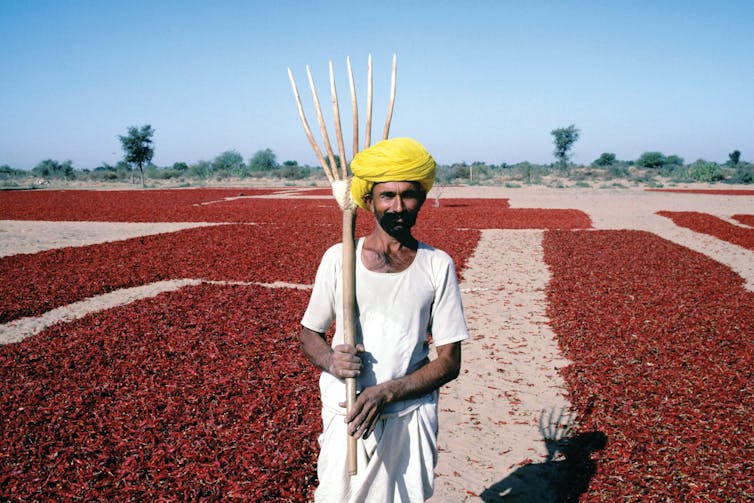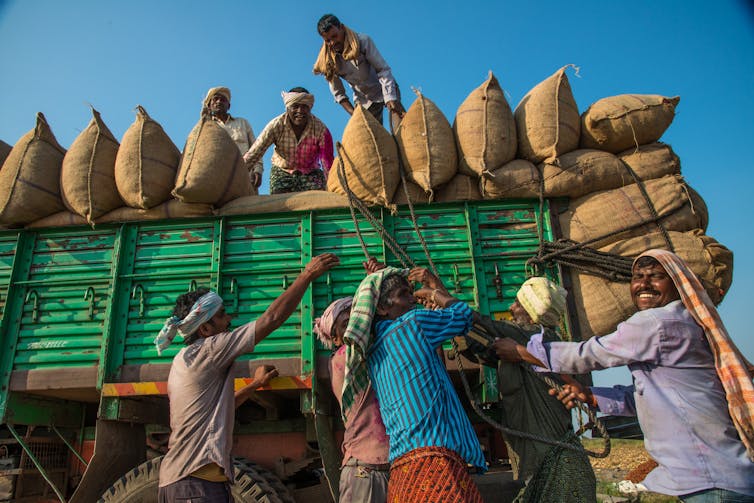Five ways India must help its farmers face the threat of climate change

Climate change could hurt farmers’ income by up to 20-25% in the medium term, according to the Indian government’s latest annual economic survey. Extreme weather events, temperature rise and lower rainfall all threaten to derail the Indian government’s agenda of doubling farmers’ income across the country.
There are ways to counter this, however. New technology and better farm management can be deployed to improve irrigration systems. And, to ensure long-term impact, it is also important that the Indian government invests in agricultural research.
Agriculture is central to the Indian economy. It accounts for 50% of the country’s employment and 18% of its GDP. And in India, about 80% of farmers are smallholders – which is generally considered to mean they have two hectares or less of land. The main crops are wheat, maize, rice, millets, pulses, sugarcane and oil-seeds.
Indian farmers must contend with a number of risks, including adverse weather, competition from larger landowners or food corporations and price surges. Small farmers are a vulnerable population where social, market and economic pressures are huge, often leading to considerable distress. India is home to nearly 25% of the world’s hungry population and has an alarming rate of farmer suicide (around 60,000 cases in the past three decades).
So the effects of fluctuations in weather, temperature and rainfall on agricultural productivity will have a significant impact on the wider population.
Climate change
Extensive meteorological data in the recent government report shows that average temperatures are rising across the country and annual rainfall is declining. It also shows a rise in the number of days with extremely high temperatures and a corresponding decline in the number of days with low temperatures.
Extreme temperature shocks, when a district is significantly hotter than usual, results in a 4.7% decline in agricultural yields. Similarly, when it rains significantly less than usual there is a 12.8% decline.

Areas lacking in irrigation are worst affected by these extreme weather conditions. A temperature shock in an area that is not irrigated reduces yields by 7.6%. Similarly, the effects of extreme rainfall shocks are 14.7% higher in areas without irrigation – much larger than the effects these shocks have in irrigated districts.
Lower yields mean lower incomes for farmers. The report estimated that extreme temperature shocks will reduce farmers’ incomes by 4.3% and extreme rainfall shocks will reduce incomes by 13.7%. In a year where temperatures are 1℃ higher, farmers’ incomes would fall by 6.2% in unirrigated districts. Similarly, in a year when rainfall levels were 100mm less than average, farmers’ incomes would fall by 15%.
Temperatures in India are likely to rise by 3 to 4℃ by the end of the 21st century. It follows that in the absence of any adaptation by farmers, farm incomes will be lower by 20 to 25% on average in the coming years, especially in the unirrigated areas.
There are five important ways to mitigate against this that the Indian government could start investing in now.
1. Smart irrigation
There is a significant need for an appropriate irrigation system considering rising water scarcity and depleting groundwater resources. Less than 50% of agriculture in India is irrigated.
States such as Karnataka, Maharashtra, Madhya Pradesh, Rajasthan, Chhattisgarh and Jharkhand are still extremely vulnerable to climate change due to poor irrigation. Smart irrigation systems such as drip, sprinklers and efficient water management should be made a priority and allocated across the country where needed.
2. Reduce post-harvest loss
Post-harvest loss of major agricultural produce is estimated at US$13 billion . About 16% of fruits and vegetables, valued at US$6 billion were lost in the year 2015. Only 2.2% of fruits and vegetables, the most perishable of agricultural produces, are sorted and packed for consumption in India, increasing the chances of wastage as it gets sent abroad. In contrast, the US (65%) and China (23%) are far ahead of India in processing their own crops.
Small landholders lose out the most from this. It is not economically viable for most of them to transport their produce for centralised large-scale processing – and they lack local processing and preservation technologies. This results in a lot of wastage. This is then compounded by inadequate transport infrastructure – produce gets damaged on the journey because of bad roads, gets contaminated from repeated loading and unloaded, as well as lack of refrigeration.
Small farms also suffer from their reliance on middlemen to sell their product. As a result, they are sometimes compelled to sell it at less than the cost of producing it.

So there is an overwhelming need to develop technologies for local processing, smart packaging and transport facilities which do not disadvantage small farmers.
3. Data driven supply-chain management
India must start using data to continuously improve the efficiency of its agricultural supply chains. New technologies such as sensors, GPS and satellite imaging can help collect meaningful data to make India’s agriculture system more resilient.
This enables different sections of the supply chain to monitor environmental and other conditions. It can be used to adapt how crops are produced, stored and distributed to reduce waste.
4. Farmer-centric crop insurance
To compensate for the uncertainty caused by climate change, an effective crop insurance programme is required to protect farmers from bad yields. Many already pay into insurance programmes but they provide little protection. The system needs overhauling so that small farmers are protected by low premium and long-term insurance cover, instead of being designed, as it seems to be at the moment, purely for the profit of insurance companies.
5. Evidence based research
Agricultural research will be vital in increasing yields but also in increasing resilience to all the problems that could come with climate change – including extreme heat and precipitation, pests and crop disease. Research will be especially important for crops such as pulses and soybean, which are crucial crops and highly vulnerable to weather and climate change.
![]() These measures will improve crop and water management practices. They are tailored to small farmers and to the fragmented, small-scale agricultural landscape – to directly improve efficiency, boost productivity and minimise the environmental impact on farming.
These measures will improve crop and water management practices. They are tailored to small farmers and to the fragmented, small-scale agricultural landscape – to directly improve efficiency, boost productivity and minimise the environmental impact on farming.
Manoj Dora, Senior Lecturer in Operations & Supply Chain Management, Brunel University London
This article was originally published on The Conversation. Read the original article.
First published: 20 February 2018, 16:28 IST
